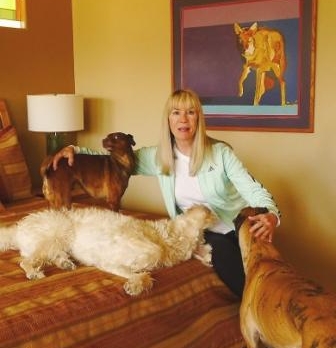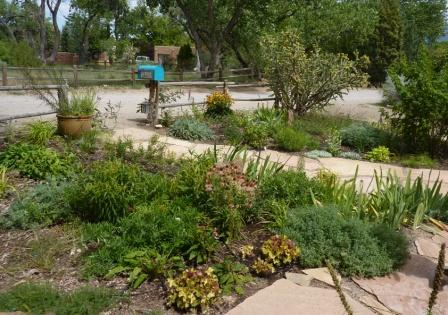
Coyote crusader
Greyhound rescuer steps up as Corrales'
next voice for wild dogs
Judy Paulsen has made herself known in the world of animal causes in the two years since she moved to Corrales from Tijeras. The director of Greyhound Companions of New Mexico, a rescue group she founded in 1994, Paulsen gravitated to all things dog upon arrival—only to immerse herself in animal campaigns from banning puppy mills to coyote-killing contests soon after. Paulsen seemed to be winding down her rescue work with Greyhounds when a new passion set her off running.
And when Paulsen runs, it’s more than just exercise. Lean and animated, a far cry from the weepy animal nut who collects too many pets, she rarely owns more than three. Instead, she works out her passion in the political arena with the tenacity of a hound on the scent. And the stink she can’t stop chasing nowadays is the rise of anti-coyote fever in New Mexico.
An avid trail runner, Paulsen would often come across coyotes while running with her dogs in Tijeras. Not only did the coyotes never bother her, she noticed that their scat consisted mostly of fruit—apples and prickly pear—plus the occasional turquoise streak of D-Con.
“Coyotes are opportunists,” she notes. “Just because you find tracks around a kill does not mean they did the killing.”
Surprised to encounter coyotes in the Corrales bosque, Paulsen admits to taking a special interest in the animals since childhood, when she grew up around wildlife in the ranching country around Socorro. “But I had never heard of killing contests,” she adds, her eyes growing wide. “There were predators, and some would cause problems and be shot. But most ranchers don’t want the whole population shot, because coyotes take care of vermin.”
Recent letters in the Corrales Comment demanding that “something be done” about the coyote population, followed by the same demands made in front of the Village Council last month, have only increased her alarm. Paulsen had been noting for the last year that some of her new neighbors see coyotes themselves as vermin.
“I can’t stop thinking about that poor coyote,” she wrote to the Bosque Beast after hearing about an animal shot (illegally) on land belonging to Peter Kaserer and Alana McGrattan in south Corrales in February. Within two days, Paulsen had interviewed Kaserer, toured the shooting site, grilled Animal Control, and started the wheels in motion for an educational event in Corrales about how to discourage coyote predation—all during a week when she was driving nearly every day to Santa Fe to lobby for passage of HB 316, a ban on coyote-killing contests. When she got word that coyote-haters were addressing the Corrales Village Council, Paulsen changed gears to marshal support, arrange meetings, and consult with wildlife experts.
Such tireless activism is possible partly because of a series of sudden tragedies in her adult life. In 1989, Paulsen became one of thousands of consumers permanently damaged by contaminated L-tryptophan, an amino acid supplement. Diagnosed with brain lesions and chronic eosinophilia myalgia, she was forced to quit her job after 20 years in an optometry office.
In 2010, she was again brought to a halt when her husband Paul suffered a ruptured brain aneurysm and needed 24-hour care. A former airline pilot, Paul Paulsen eventually regained the ability to walk and talk, only to suffer a new decline in the last year that forced him into an assisted-living facility. This left his wife suddenly free to devote herself to animal causes full-time.
In January she was interviewed by KOB-TV about her work with Greyhounds, which generated a fresh round of threats from the dog-racing industry. At the height of her activism against dog racing in the mid-1990s, Paulsen grew fearful enough to get a concealed-carry handgun permit, and still keeps a gun she knows how to use. She has seen her tires slashed, the windows in her van broken, and thinly veiled threats from Greyhound trainers and owners. But Paulsen is not about to stand down.
“I was an animal advocate for a while, but now I’m an activist,” she says, the trace of a quiver in her voice. “Because I believe animals have rights.”
Her interest in Greyhounds began simply enough. In the early 1990s, when she was still stuck on Dobermans—she owned four altogether—she was handed a flyer about the use and abuse of racing Greyhounds, a topic she knew nothing about. She had never even seen a Greyhound.
“I thought, how can I ever see one? They never had dog racing in New Mexico. So I contacted the author of the article, and he said go to the nearest state with a track.”
So Paulsen loaded up a motor home with her mother and aunt, and headed to Colorado Springs so they could get a look at this intriguing dog breed. On the return, they were joined by three freshly adopted Greyhounds running crazy on their first car ride after a lifetime spent in a crate.
Two of the dogs were for Paulsen herself: a blue brindle named Lotto, shy and fearful, and her kennel mate Bart, “black and really funny—his whole body would wag. He was actually grinning when I met him,” she said. “He just blew me away.”
She soon noticed that Greyhounds differ from other dogs because of the way they are bred and raised. Crated all their lives, with little human contact, they are continuously “culled” for speed, and discarded when they don’t win races. The industry used to kill some 40,000 dogs a year this way, until bad publicity led them to place rejected dogs with adoption groups that agreed not to malign the industry. Paulsen took no such a vow.
“I’ve gone undercover, I could tell you—it’s horrible what these dogs go through,” she says, crediting friends in the industry for opening her eyes. “I’m not a typical adoption person who says what they’ve been told. I have seen it.”
She is the first to bring up the mixed blessing of a rural New Mexico childhood in her evolving animal advocacy—recalling both the freewheeling days spent running across bobcats, mountain lions, all manner of wildlife and pets—and a violent, alcoholic father who made it a relief to get outside, and who turned her into a lifelong enemy of hunting.
“He used to take me along, and he usually got something,” she recalls. “My mom would cook the whole animal, and Dad tanned the hide. One day my dad started gutting a live deer—I can’t remember the specifics, but the deer was looking at me, and I could see the pain in its eyes. It was awful,” she shudders. After that, she always found a reason to be unavailable for hunting trips. Eventually she stopped eating meat.
Even in that environment, though, Paulsen never saw killing frenzies like the one organized by Calibers gun shop in Albuquerque last December, and ultimately put on by Gunhawk Firearms in Los Lunas, which netted 39 coyotes. “Growing up, it was like, if we’re leaving them alone and they’re leaving us alone, just let things be. Why do you have to do something about them?”
When it comes to humans, though, Paulsen can’t not do something about cruelty to animals, either wild or domestic. “People will say they’re neutral on the subject,” she says of her lobbying at the Legislature for the (failed) ban on coyote-killing contests. “But when it comes to animal cruelty, you can’t be neutral.”

Fresh inspiration for the xeric garden
One of the highlights of the 2013 Corrales Garden Tour will be a creative xeric garden built by the homeowners on East Ella Road. Beginning with soil amendment many years ago, the garden has evolved over the last four years of plantings, arbors, outbuildings, vegetables, garden art, and a new chicken coop. The results should be in fine flower during this year’s tour, Sunday, June 9, from 9 to 4.
At least a half dozen gardens are on the self-guided tour, including one at a business, with Sandoval County Master Gardeners on hand at each stop to answer questions. This is the fourth year for the fundraiser, which features a different set of outstanding Corrales gardens each year to offer inspiration and help for homeowners in our challenging high-desert environment. Both bosque and sandhill gardens will be featured, and some of the gardens offer privileged views. Proceeds benefit the Corrales Main Street project to landscape pathways planned for Corrales Road.
Visitors are invited to visit the four wineries around Corrales, and to combine the tour with a meal at one of the Village restaurants. Tickets will be available for $10 starting May 1 at local nurseries (Alameda Greenhouse, Great Outdoors Nursery, Jericho Nursery, Osuna Nursery, Plant World, Plants of the Southwest, Santa Ana Garden Center) as well as in Corrales at the Village Mercantile, Frontier Mart, Oasis and Frame ‘n’ Art. Tickets can also be bought the day of the tour at tents along Corrales Road.
